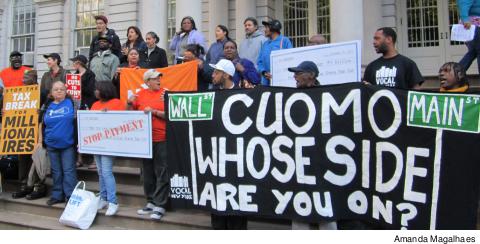Millionaires’ tax is needed
 |
The fate of the so-called millionaires’ tax, a multibillion dollar revenue generator for the state, was unknown, as the details of the New York State budget were being finalized by state lawmakers at Clarion’s press time. Assembly Democrats were pushing for an extension and expansion of the tax, which expires this December, while Senate Republicans vied for the tax not to be renewed. In January of this year, Governor Andrew Cuomo called to renew the tax, and said without it, there would be a hole in the state budget.
The PSC, along with other labor and community groups, has been calling on this needed revenue-generator, which could be used for K-12 public education and fully funding CUNY.
“We haven’t been faced until now with the kind of dramatic cuts in funding we’re about to incur,” said PSC First Vice President Michael Fabricant, who noted that New York City has the most millionaires and billionaires of any city in the country, and the state has the greatest income inequality of any state in the country. “The fairest way of approaching [these cuts] is that those who can pay more, should pay more.”
BUDGET SHORTFALLS
The state may ultimately have to make up for shortfalls from the federal budget, with President Donald Trump’s proposed budget slashing funding for affordable housing, health care research, environmental protection and transportation projects in the state, according to an Associated Press report. The Fiscal Policy Institute (FPI) calls the extension and expansion of the millionaires’ tax a tool to address essential priorities in the state.
“The proposed extension of the millionaires’ tax will help New York continue to support statewide priorities from education to health care,” states a brief from the Fiscal Policy Institute on expanding the tax. “The tax will help offset the regressive nature of New York’s overall state and local tax burden, particularly when paired with enhanced low-income tax credits and additional high-end tax brackets.”
ASSEMBLY-BACKED PLAN
The tax, which went into effect during the Great Recession, is set to expire at the end of this year. Currently it levies an 8.82 percent tax rate on household incomes above $2 million and individual filers with incomes above $1 million. Democrats in the assembly put forward a plan that would expand the tax and create four new tax brackets for high-income earners, with a 10.32 percent tax for highest earners, households earning more than $100 million. This new tax structure is estimated to bring in more than $5.6 billion in additional revenue and would affect about 45,000 taxpayers in the state, while proposed middle-class tax cuts would affect six million New Yorkers, according to the online legal news service Law360.
A similar plan, which included incremental tax increases to the top 1 percent of earners in the state, has been advanced by the Fiscal Policy Institute and supported by dozens of millionaires in the state. The FPI plan, known as the “1% Plan for New York Tax Fairness,” would start incremental increases for household incomes beginning at $665,000, and it would have 12 income tax brackets in the state, five of which would be for the top 1 percent of earners. FPI estimates that their proposal would raise about $6.2 billion, $2.5 billion dollars more than Governor Cuomo’s proposed extension of the millionaires’ tax. In the run-up to finalizing the budget, wealthy New Yorkers urged state lawmakers to support the FPI proposal. More than 80 top 1-percent earners in the state, including Eileen Fisher, Abigail Disney and Steven C. Rockefeller, signed on to a letter supporting the FPI plan.
“We are upper-income New Yorkers who treasure the quality of life in our state,” read the letter. “As business leaders and investors, we know that the long-term stability and growth of a company requires investments in both its human capital and physical infrastructure. The same is true for our state.”
Since the enactment of the millionaires’ tax in 2009, the number of millionaires in the state increased by one third. Contrary to some conservative lawmakers’ concerns that progressive taxation would drive away the wealthiest tax payers, the FPI report cites sources stating only a few wealthy residents moved after the enactment of the tax. Recent research, the report stated, shows the rich are tied to the economic and social networks where they live and generally do not move when higher rates are enacted. Also, the report states, income inequality in New York is greater than in any other state. In 1980, 12 percent of income going to the state came from the top 1 percent; in 2015 that number was almost triple, with nearly a third of income earned by the top 1 percent.
“From 1949 to 1979, incomes rose across the board, with the middle class expanding dramatically in number and experiencing fairly steady income gains,” the report states. “For the past 35 years, however, most income gains have flowed to the very top.”

